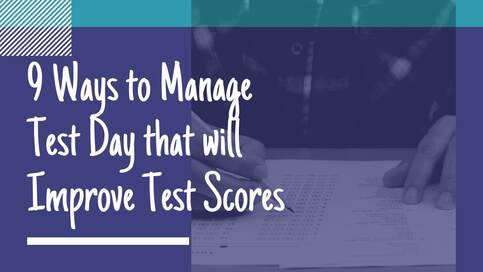9 Ways to Manage Test Day that will
Improve Test Scores
Yes, you really do need to manage your students during test time. Many teachers often sit at their desk and work while students are testing. This is okay… to a point. I’m not saying you should be constantly walking around the room while students are testing though… don’t get me wrong here! But there are things you need to do on test day to set your students and yourself up for success.
No matter what type of test you are giving – it can be a 5minute quiz or a 45 minute unit test – you must provide your students with expectations and structure.
No matter what type of test you are giving – it can be a 5minute quiz or a 45 minute unit test – you must provide your students with expectations and structure.
Now I realize you might be thinking that you already do this. And you probably do… to an extent.
By creating a structured routine for test day you are providing a safe environment where students don’t have to worry about what to do and can instead focus on showing what they know through their test.
This post will take you step by step through how I create a structured testing routine for my students, so you can do the same.
9 Steps to Managing Test Day
1) It starts with review day. I realize that sometimes scheduling is tight and review days are not always possible. But when you can, schedule in a day of review. Some teachers give students practice questions or play a review game. This is the perfect opportunity for students to learn new study strategies. Whichever approach you choose, always give students a chance to ask YOU questions concerning the material.
Related: Learn how to create an effective Study Guide that will not compromise your test.
2) Prep them the day before. Often, this is part of my review day. Tell students everything they need to know about the test day:
- Where will they sit?
- Will they have the entire class period for the test?
- Will the test be at the beginning or the end of class?
- Do they have to turn anything in on test day?
(my students always turn in their notebooks on test day)
- What is the test format? What will it look like? How many pages? How many questions?
Knowing these things ahead of time helps to put students’ minds at ease and be able to focus.
3) Teach them expectations for Test Mode. Learning to be Test Mode Ready is one of my classroom procedures. You can download it for FREE
While in Test Mode, students should only have materials needed for their test, on their desk. For my class, that means pencil and eraser. ALL other materials MUST go under their chairs, on the floor. This means ALL binders, notebooks, and pencil cases. Students are not allowed access to their things on the floor during the test. I require things to be under the chair so nobody trips over them in the aisle. I always joke about how if I end up on crutches during snowmobile season because I tripped on their binder – they will have a very unhappy Ms. Midgley on their hands!!
4)Going along with number 3, all papers must be inside folders. This is a BIG one. Again, it is for their own protection and their neighbor’s. We don’t want anyone being accused of anything.
5) Cover Sheets. I use old file folders that are cut in half (mine are green). I tell them that the cover sheets are for their protection and that of their neighbor.
6) All students should be in their chairs during directions. This may sound like a given, but I have been surprised at how many students think it’s okay to get up and sharpen their pencil during instruction time – especially on Test Day! This issue gets squashed quickly in my classroom at the start of the year. But while we are talking about directions – once I pass out the tests I go through and read all directions aloud to the class.
Yes, we actually flip through each page together so I can point out each section. This step gives students time to see the material before they just start working. It helps calm nervous testers too. It also helps eliminate the student who forgot to complete an entire section because they didn’t know it existed.
7) Directions on the board for after the test. Where do students turn in their test? Where does their cover sheet go? What do they do next?
I always have students read at the end of a test. They can read their own (which should be sitting on top of their things under their chair) or they can borrow from the selection I have at the front of the classroom – these books are usually a combination of my own and what I have checked out from the library. They are all on topic of our next unit of study.
Again, I don’t allow students into their things during test time. EVEN if they are already done with their own test and turned it in. I explain to students that out of respect for their classmates who are still trying to work and it is not fair for them to listen to you shuffling through your binder. ALL students deserve a focused working environment so EVERYONE can do their best on their test.
8) Rotate every 6-7 minutes. It’s important the teacher does not get stuck at their desk during test time. Yes, I do sit and get work done while students are testing. But every 6-7 minutes I get up and walk a rotation through my students.
I am actively monitoring of course to prevent cheating. But I am also checking to see student progress. I can see if someone is stuck and then I can redirect. I am also making myself available to students who may have questions. A confused student is more likely to ask a question if the teacher is walking by. Most times I find the question is about the wording on the test or how a particular item is phrased. They want to make sure they understand what to do.
9) At the end of the testing period, check in with your students. How did they feel about the test? What went well? What was challenging?
Students often want to know when they can expect their test to be graded. Give them a time frame. Even if they won’t get it back for a week – be honest with them.
Finally, what’s coming next? When does the new unit start? Get them excited!
Related: Learn how to create an effective Study Guide that will not compromise your test.
2) Prep them the day before. Often, this is part of my review day. Tell students everything they need to know about the test day:
- Where will they sit?
- Will they have the entire class period for the test?
- Will the test be at the beginning or the end of class?
- Do they have to turn anything in on test day?
(my students always turn in their notebooks on test day)
- What is the test format? What will it look like? How many pages? How many questions?
Knowing these things ahead of time helps to put students’ minds at ease and be able to focus.
3) Teach them expectations for Test Mode. Learning to be Test Mode Ready is one of my classroom procedures. You can download it for FREE
While in Test Mode, students should only have materials needed for their test, on their desk. For my class, that means pencil and eraser. ALL other materials MUST go under their chairs, on the floor. This means ALL binders, notebooks, and pencil cases. Students are not allowed access to their things on the floor during the test. I require things to be under the chair so nobody trips over them in the aisle. I always joke about how if I end up on crutches during snowmobile season because I tripped on their binder – they will have a very unhappy Ms. Midgley on their hands!!
4)Going along with number 3, all papers must be inside folders. This is a BIG one. Again, it is for their own protection and their neighbor’s. We don’t want anyone being accused of anything.
5) Cover Sheets. I use old file folders that are cut in half (mine are green). I tell them that the cover sheets are for their protection and that of their neighbor.
6) All students should be in their chairs during directions. This may sound like a given, but I have been surprised at how many students think it’s okay to get up and sharpen their pencil during instruction time – especially on Test Day! This issue gets squashed quickly in my classroom at the start of the year. But while we are talking about directions – once I pass out the tests I go through and read all directions aloud to the class.
Yes, we actually flip through each page together so I can point out each section. This step gives students time to see the material before they just start working. It helps calm nervous testers too. It also helps eliminate the student who forgot to complete an entire section because they didn’t know it existed.
7) Directions on the board for after the test. Where do students turn in their test? Where does their cover sheet go? What do they do next?
I always have students read at the end of a test. They can read their own (which should be sitting on top of their things under their chair) or they can borrow from the selection I have at the front of the classroom – these books are usually a combination of my own and what I have checked out from the library. They are all on topic of our next unit of study.
Again, I don’t allow students into their things during test time. EVEN if they are already done with their own test and turned it in. I explain to students that out of respect for their classmates who are still trying to work and it is not fair for them to listen to you shuffling through your binder. ALL students deserve a focused working environment so EVERYONE can do their best on their test.
8) Rotate every 6-7 minutes. It’s important the teacher does not get stuck at their desk during test time. Yes, I do sit and get work done while students are testing. But every 6-7 minutes I get up and walk a rotation through my students.
I am actively monitoring of course to prevent cheating. But I am also checking to see student progress. I can see if someone is stuck and then I can redirect. I am also making myself available to students who may have questions. A confused student is more likely to ask a question if the teacher is walking by. Most times I find the question is about the wording on the test or how a particular item is phrased. They want to make sure they understand what to do.
9) At the end of the testing period, check in with your students. How did they feel about the test? What went well? What was challenging?
Students often want to know when they can expect their test to be graded. Give them a time frame. Even if they won’t get it back for a week – be honest with them.
Finally, what’s coming next? When does the new unit start? Get them excited!
Final Thoughts...
Simply providing a testing structure can really put your kids at ease and help them focus on what’s important.
Teach your kids to be Test Mode Ready. You can use my classroom procedure. You can download it for free below! You can also purchase my entire Classroom Management Plan of 22 ready-to-go procedures for your classroom.
Teach your kids to be Test Mode Ready. You can use my classroom procedure. You can download it for free below! You can also purchase my entire Classroom Management Plan of 22 ready-to-go procedures for your classroom.
You Might Also Like...
Let's Connect...

Welcome! I'm Hillary Midgley, a veteran 6th grade teacher.
I create educational materials and develop curriculum for other teachers. I specialize in teaching students how to learn through my Study Skills Curriculum. I have established fundamental classroom systems and structures for teachers to help them streamline their classroom. And my passion is teaching ancient history through engaging activities with foundations in academic skills. Here you will find resources on all of these topics and more. Learn more about me here.
|






